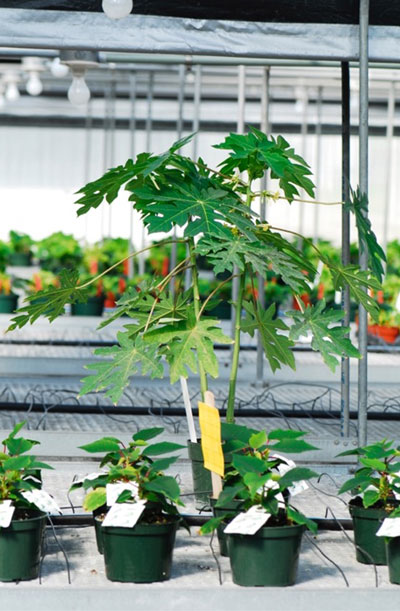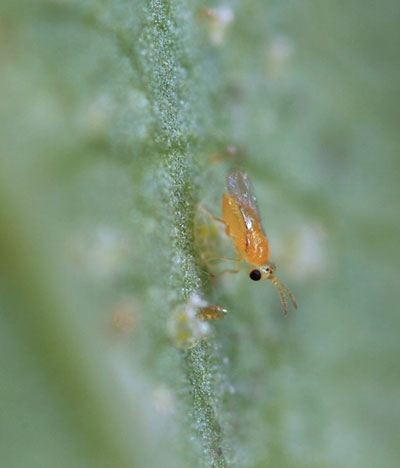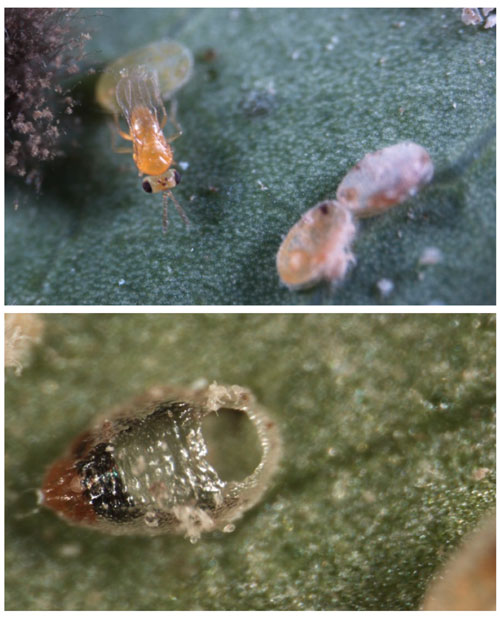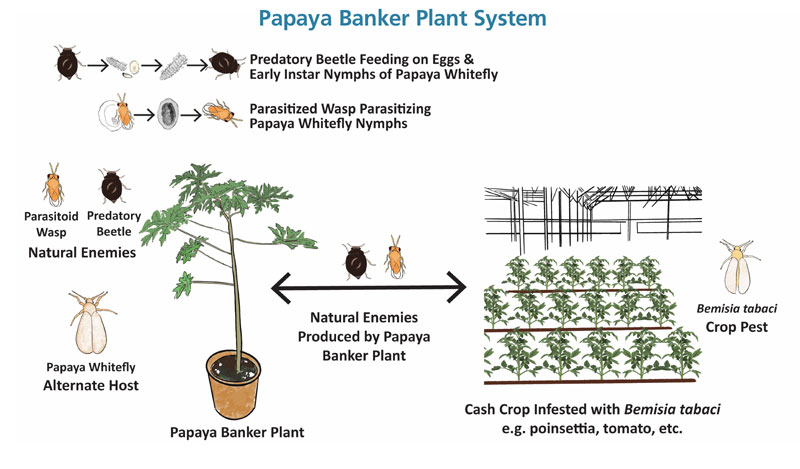5/1/2023
Whitefly Management Using Banker Plant Systems
Muhammad Z. Ahmed, Cindy McKenzie & Lance S. Osborne

Whiteflies are tiny insects that can cause tremendous damage to plants. They suck plant sap with their piercing mouthparts and excrete a sticky substance called honeydew that can cause mold to grow on the plant. In addition, they transmit plant viruses that cause disease and greatly reduce crop yields. Bemisia tabaci is one of the most notorious and destructive whitefly pests and is considered among the top 100 of the worst invasive exotic species of vegetables and ornamental crops in the world.
Pictured: A papaya banker plant among poinsettias to control whiteflies.
Bemisia tabaci is a complex of at least 40 morphologically indistinguishable cryptic species (previously known as biotypes). These cryptic species (biotypes) vary in behavior, host ranges, biology and insecticide susceptibility. In the U.S., we have three members of this complex:
A biotype (AKA New World), B biotype (MEAM1) and Q biotype (MED). The Q biotype is less susceptible to many insecticides, leaving fewer chemical options for control. In addition, insecticide resistance may develop more rapidly with the Q biotype, making it more difficult to control with insecticides.
Rationale
Whitefly natural enemies, such as parasitic wasps and predatory beetles, have been considered relatively promising for biological control. But establishing natural enemies has been the most challenging part of implementing successful biological control programs. Dr. Lance Osborne proposed the papaya banker plant system in 1991 to address this challenge.
The papaya banker plant system
The papaya banker plant system uses papaya to rear the alternate host, the papaya whitefly (Trialeurodes variabilis, which is a host specific to papaya) to deliver natural enemies. Natural enemies used in this system include parasitic wasps (Encarsia sophia) and predatory beetles (Delphastus catalinae, D. pallidus) to control the crop pest, primarily B. tabaci in greenhouse vegetables and ornamental crops. This is the only whitefly banker plant system that uses an alternate host that isn’t the pest targeted for control and has the potential to introduce multiple natural enemies simultaneously.
How the system works
The system is simple. The adult natural enemies feed on the papaya whitefly, which is only on the papaya plant (a banker plant in this system). They establish a resident population on the papaya banker plant and produce lots of eggs, which eventually hatch and develop through their life cycles.
In the case of the parasitic wasp, its female lays a single egg within an immature whitefly nymph. The wasp egg hatches and the larval stage of the wasp develops until it pupates within the whitefly. The parasitized whitefly nymph turns black once the wasp has pupated. When development is complete, the adult will emerge from the pupa and chew a round circular hole in the exoskeleton of the dead whitefly pupal stage, through which the adult female wasp will emerge and then mate with a male wasp that’s recently emerged from another parasitized whitefly. After mating, the female will search for whitefly immatures on which she will feed to gain nutrition and produce eggs that will be used to start the process all over.
 Pictured: Parasitic wasp Encarsia sophia used to control B. tabaci whiteflies.
Pictured: Parasitic wasp Encarsia sophia used to control B. tabaci whiteflies.
Wasps emerging from parasitized papaya whiteflies on the banker plant will either stay on the banker plant or move into the cash crop in search of pest whiteflies to feed on. If B. tabaci has found its way into the crop, the adult wasps will find the immature B. tabaci and attack them. If the wasps don’t find a whitefly to attack, they die or return to the papaya banker plant to reproduce on papaya whitefly. They act essentially as scouts, but have a much greater incentive to find whiteflies than your typical scouts.
In the case of predatory beetles, mated females feed on papaya whitefly eggs, nymphs or adults if she can catch them. Once nutrition has been obtained by feeding, the adult female lays eggs on the whitefly-infested leaves. The larvae hatch and search for any life stage of the whitefly and begin feeding on it.
The larvae feed voraciously through their life cycle and pupate. Adult beetles emerge from the pupae. Some of these adults will remain on the papaya banker plant to produce future generations, but many will disperse into the cash crop being protected. These dispersing adults will search throughout the crop for other pest whiteflies and begin to feed on them. When the populations of whiteflies are very low, new banker plants can be added to feed them, thus maintaining the established population of natural enemies and providing long-term pest whitefly suppression.
A major benefit to the banker plant systems is they’re portable. Banker plants can be moved or covered with plastic if a grower wants to spray the crop for other pests or even whiteflies and then put back for continued use.
Another benefit of the banker plant system is that you can use multiple systems targeting more than one pest species. For example, we used the papaya banker plant with an ornamental pepper banker plant that simultaneously targets mites, thrips and whiteflies to control the entire spectrum of pests found in poinsettia.
Another benefit of the two natural enemies we’re using (wasps and beetles) is that they leave evidence that they’ve been active in the crop. The parasitized whiteflies appear black before the adult wasp emerges and they leave a round circular hole in the pupal whitefly skin. The beetles leave small yellow stains on the leaves, which are their excrement. The presence of this material indicates the adults have been feeding and are active in the pest population.

History of the papaya banker plant system
We chose papaya and the papaya whitefly for our banker plant system because the host plant can easily grow from seeds we harvest from papaya purchased at our local grocery store. Papaya plants can support heavy papaya whitefly populations. The papaya whitefly is host specific to papaya and won’t become a pest in the cash crop (cucumber, hibiscus, lantana, poinsettia, tomato, etc.) we’re trying to manage. Care must be taken not to position the banker plants within the crop because the dense populations of whiteflies that develop also produce copious amounts of honeydew that will contaminate any plants below or near the banker plant.
Pictured: A female parasitic wasp laying an egg in an immature whitefly nymph.
• Parasitized whiteflies appear black before the adult wasp emerges, leaving a round circular hole in the pupal whitefly skin as they emerge.
For our parasitic wasp, we use E. sophia, a tiny wasp native to Florida that feeds on and parasitizes whitefly nymphs and poses no threat to anything but whiteflies.
For our predator, we started out using the predatory beetle, D. catalinae (formerly D. pusillus), which is an indigenous natural enemy that’s often found feeding on papaya whiteflies in Central Florida. In fact, the first grower to report the B. tabaci B biotype in the U.S. found this beetle in his father’s backyard feeding on his papaya whitefly population. He brought this to the attention of Dr. Osborne, who developed a colony and demonstrated its utility as a biological control agent of B. tabaci.
Always trying to increase the utility of banker plants, our papaya banker plant system initially developed for greenhouse-grown hibiscus and its success has led us to introduce it into many greenhouse grown crops. Its utility was successfully evaluated in Florida’s commercial greenhouse poinsettia operations to distribute E. sophia and D. catalinae for controlling B. tabaci B biotype and demonstrated a reduction in insecticide applications. B. tabaci is generally much more challenging to manage on poinsettia than almost any other ornamental foliage plant. We felt that if it had successfully managed B. tabaci on this crop with our papaya banker plant system, we could now control B. tabaci on most ornamental foliage plants. The results exceeded our expectations.
We’ve also demonstrated that the system could be used outdoors to manage B. tabaci on bedding plants. One of Florida’s theme parks utilized banker plants to produce natural enemies to use throughout one of their properties. They grew papaya in a location outside of the view of guests. They would collect the parasitic wasps and predatory beetles by removing a leaf that had the natural enemies on it and then place it in the canopy of the bedding plants in public areas. This was successful, but discontinued when neonicotinoids were introduced.
In our multi-year surveys of the natural enemies of whiteflies in South Florida, we found another Florida native natural enemy—the predatory beetle D. pallidus preying on at least six different whitefly species. Adults and larvae of D. pallidus prey on all immature stages of whiteflies. In addition to our field surveys, our lab experiments indicate D. pallidus could be used for controlling multiple whitefly pests of ornamentals. Currently, we’re studying this beetle’s predatory potential for B. tabaci in greenhouse poinsettia using the papaya banker plant system at the USDA in Fort Pierce. Earlier work has shown these two predatory beetles (D. catalinae and D. pallidus) prey equally on both B and Q biotypes of B. tabaci, indicating our papaya banker plant system can control both biotypes, which would be the ultimate goal since both could be in commercial greenhouses intermixed.
The papaya banker plant system holds great potential as a non-chemical alternative by supporting self-sustaining colonies of natural enemies for the management of B. tabaci in Florida. We believe this system will help growers establish a highly effective complex of natural enemies in their crops. Employing such strategies will reduce insecticide applications and the associated risk of insecticide resistance development in B. tabaci biotypes.
Funding for this research was provided by the USDA-ARS Floriculture and Nursery Research Initiative. GT
Lance S. Osborne is with the University of Florida, IFAS and Mid-Florida Research & Education Center. Cindy McKenzie and Muhammad Z. Ahmed are with the USDA-ARS Horticultural Research Laboratory in Fort Pierce, Florida.
Pictured below: Papaya banker plant system sustaining colonies of natural enemies on papaya banker plant and delivering to cash crops (including poinsettia, tomato, etc.) to control crop pest, Bemisia tabaci.
